| Article ID | Journal | Published Year | Pages | File Type |
|---|---|---|---|---|
| 4914031 | Construction and Building Materials | 2016 | 9 Pages |
Abstract
Due to shrinkage and/or inadequate compaction during concreting, voids may develop in a concrete-filled steel tube (CFST) between the concrete core and outer steel tube, which reduce the confinement effect of the steel tube on the concrete core, and further, decrease the load-carrying capacity and ductility of a CFST. In this study, an ultrasonic technique is utilized for quantifying voids in CFSTs by analyzing the ultrasound travel time in them. Four potential travel paths are identified in CFSTs with/without pre-set voids. By making a comparison of the experimental and theoretical ultrasound travel time, the actual ultrasound travel path is determined in CFSTs. Further, by analyzing the matrix of ultrasound travel time obtained from experiment, a novel method is proposed to generate the chromatogram of the distribution of ultrasound travel time, which is utilized to quantify the voids in a CFST. The chromatogram intuitively shows the position and geometry of the voids in CFSTs and is in reasonable agreement with the pre-set voids. This study, therefore, establishes a new method for quantifying voids in a CFST through the ultrasonic technique.
Related Topics
Physical Sciences and Engineering
Engineering
Civil and Structural Engineering
Authors
Wei Dong, Zhimin Wu, Xiangming Zhou, Yongjie Tan,
